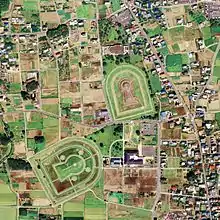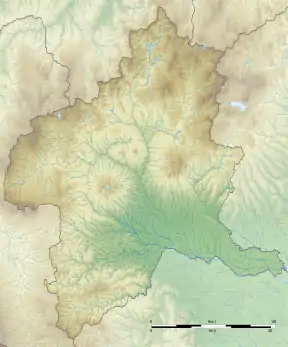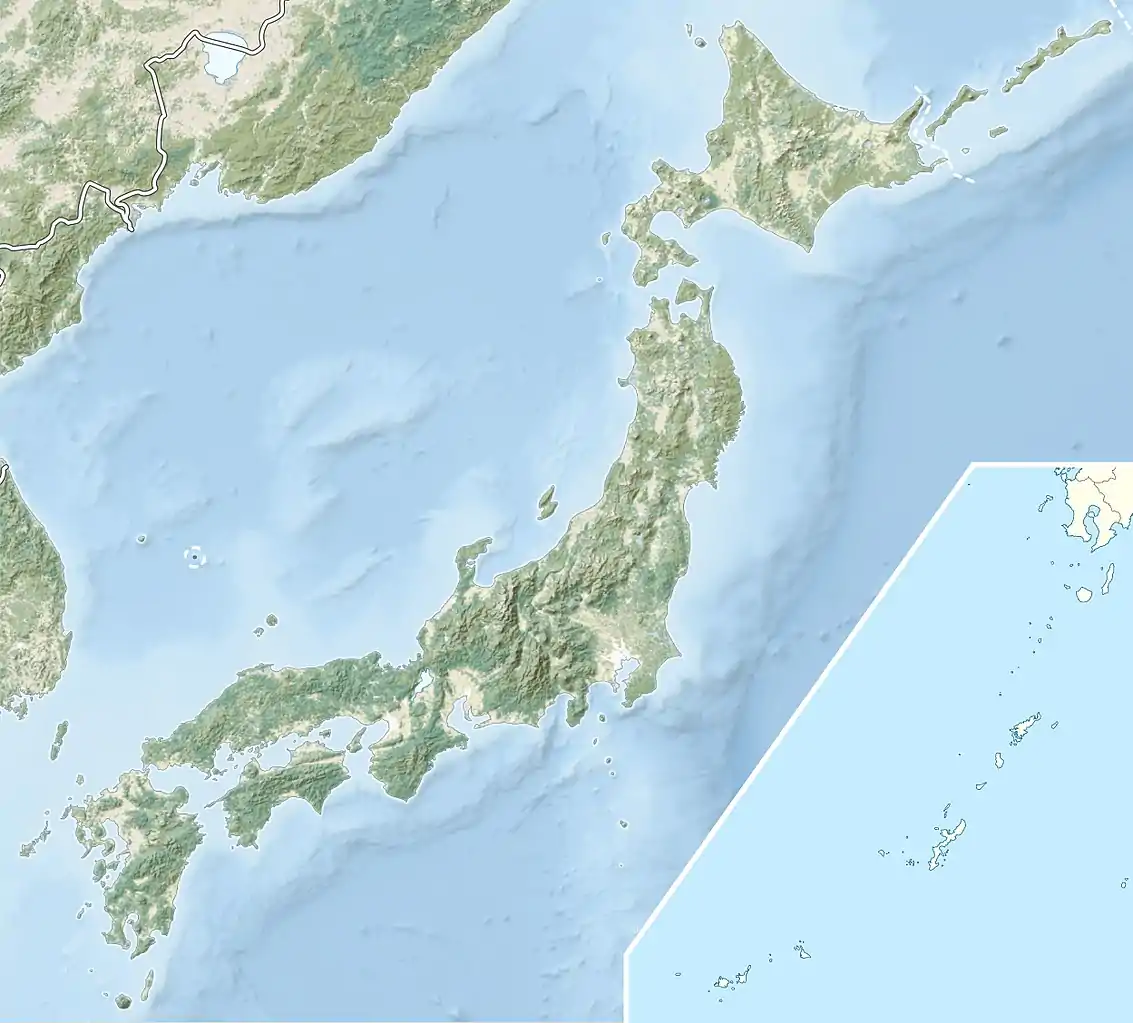Hodota Kofun Cluster
The Hodota Kofun Cluster (保渡田古墳群) is a group of three Kofun period keyhole-shaped burial mounds located in what is now the city of Takasaki, Gunma Prefecture in the northern Kantō region of Japan. It was designated a National Historic Site of Japan in 1985.[1]
保渡田古墳群 | |
 Hodota Kofun Cluster | |
 Hodota Kofun Cluster  Hodota Kofun Cluster (Japan) | |
| Location | Takasaki, Gunma, Japan |
|---|---|
| Region | Kantō region |
| Coordinates | 36°22′51″N 138°59′09″E |
| Type | kofun |
| History | |
| Founded | late 6th century |
| Periods | Kofun period |
| Site notes | |
| Public access | Yes (Park) |
Overview
This group of burial mounds is distributed at the southern foot of Mount Haruna, and were constructed from the end of the latter half of the 5th century to the first half of the 6th century AD. The Futakoyama Kofun is both the largest and oldest of the group and is located to the southwest. The Hachimanzuka Kofun is in the northeast, and the Yakushizuka Kofun, which is the youngest, is in the northwest. Information on excavated items and archaeological sites is displayed at the neighboring Kamitsuki Village Museum.
Futagoyama Kofun
The Futagoyama Kofun (二子山古墳) has three tiers and a length of 108 meters. The bottom two tiers were covered in fukiishi and rows of cylindrical haniwa were found on top and on the terrace between the two tiers. Other types of haniwa shaped as human figures, horses and other animals, and houses, etc. were also found. The tumulus was surrounded by a double horseshoe-shaped moat, and there are four smaller dome-shaped tumuli within the inner moat, flanking the posterior circular portion of the main tumulus of all sides. The burial chamber is located at the center of the apex of the circular portion of the tumulus, and consists of a river stone-lined pit-type room with a boat-shaped stone sarcophagus. The tomb has been robbed in premodern times and the lid of the sarcophagus is missing. Grave goods missed by the robbers included a decorative iron sword, gilt-bronze shoes, iron farm implements and stone imitations of everyday objects and other ornaments. Currently, the chamber is backfilled for preservation.
- Overall length: 108 meters
- Posterior circular portion: 74 meter diameter x 10 meters high
- Anterior rectangular portion: 71 meter width x 7 meters high
Hachimanzuka Kofun
The Hachimanzuka Kofun (八幡塚古墳) has a length of 102 meters, but its original height is uncertain since the top of the tumulus has been shaved off. The mound was covered in fukiishi and rows of cylindrical haniwa were found on top . Other types of haniwa shaped as human figures, horses and other animals, and houses, etc. were also found, and of especially interest was a haniwa in the shape of a cormorant with a fish in its beak. The practice of cormorant fishing was documented in the Chinese Book of Sui from the same period as the Kofun period in Japan, and this was the first physical evidence corroborating the Chinese history. The tumulus was surrounded by a double horseshoe-shaped moat, the inner dike of which also had fukiishi. As with the Futagoyama Kofun, there are four smaller dome-shaped tumuli within the inner moat, flanking the circular portion of the main tumulus of all sides. The Hachimanzuka Kofun was also robbed in antiquity, and the burial chamber has collapsed. Fragments of swords and other weapons, fragments of armor and shards of Sue ware pottery have been found.
- Overall length: 102 meters
- Posterior circular portion:56 meter diameter x 6 meters high
- Anterior rectangular portion: 53 meter width
Yakushizuka Kofun
The Yakushizuka Kofun (薬師塚古墳) is thought to have had a length of over 100 meters, and to have been of two-tied construction with fukiishi and rows of cylindrical haniwa, with a double moat. However, a large portion of the tumulus was destroyed with the construction of an adjacent Buddhist temple and its graveyard. The tumulus was excavated in 1683, and the stone boat-shaped sarcophagus remains on the mound. Some of the surviving grave goods are stored at the temple of Saiko-ji, and are now Important Cultural Properties of Japan.[2]
 Hachimanzuka Kofun
Hachimanzuka Kofun Hachimanzuka Kofun sarcophagus
Hachimanzuka Kofun sarcophagus Futagoyama Kofun
Futagoyama Kofun Yakushizuka Kofun
Yakushizuka Kofun Kamitsukeno-sato Museum of Archaeology
Kamitsukeno-sato Museum of Archaeology
References
- "保渡田古墳群" (in Japanese). Agency for Cultural Affairs. Retrieved August 20, 2020.
- Agency for Cultural Affairs
External links
| Wikimedia Commons has media related to Hodota-kofungun. |
| Wikimedia Commons has media related to Kamitsukenu Haniwano-sato Park. |
- Takasaki City official guide (in Japanese)